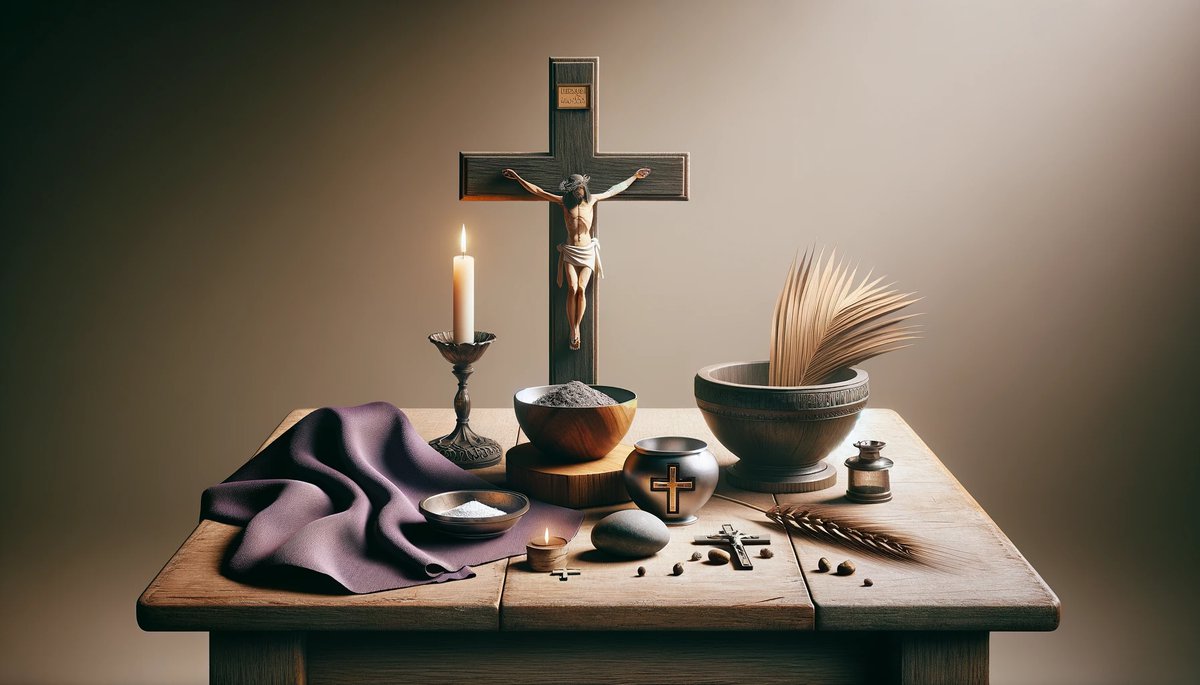Home>Theology and Spirituality>What Are The Symbols For Baptism


Theology and Spirituality
What Are The Symbols For Baptism
Published: February 26, 2024
Jason DeRose, Managing Editor at Christian.net, uses his expertise in religion and journalism to deepen understanding of faith's societal impacts. His editorial leadership, coupled with a strong academic background, enriches the platform’s diverse content, earning him recognition in both journalism and religious circles.
Discover the significance of baptism symbols in theology and spirituality. Explore the meaning and importance of baptismal symbols in various religious traditions.
(Many of the links in this article redirect to a specific reviewed product. Your purchase of these products through affiliate links helps to generate commission for Christian.net, at no extra cost. Learn more)
Table of Contents
Introduction
Baptism is a significant sacrament in Christianity, symbolizing the cleansing of sins and the initiation into the faith. It is a rite of passage that holds deep spiritual meaning for believers. Throughout the baptism ceremony, various symbols are employed to represent different aspects of the Christian faith and the individual's commitment to their religious journey. These symbols serve as powerful visual reminders of the spiritual significance of baptism and are rich in historical and religious symbolism. In this article, we will explore the key symbols associated with baptism and their meanings in the Christian tradition.
Read more: What Does Baptism Symbolize To Christians
The Sign of the Cross
The Sign of the Cross is a fundamental symbol in the Christian faith, representing the crucifixion and resurrection of Jesus Christ. During the baptismal ceremony, the priest or minister makes the sign of the cross on the forehead of the person being baptized. This act symbolizes the individual's acceptance of Christ's sacrifice and their commitment to following His teachings. The sign of the cross is made by touching the forehead, then the chest, and then each shoulder, forming a cross shape. This gesture is a powerful reminder of the central tenets of the Christian faith and the believer's identification with the life, death, and resurrection of Jesus.
The act of making the sign of the cross is also a form of blessing, invoking the presence and protection of the Holy Trinity – the Father, the Son, and the Holy Spirit. It is a physical expression of faith and a symbol of divine protection and guidance. The sign of the cross is a deeply ingrained tradition in Christian worship and is a visible symbol of one's identity as a follower of Christ. It is a simple yet profound gesture that holds great significance in the lives of believers, particularly during the sacrament of baptism.
Water
Water is a central symbol in the sacrament of baptism, representing purification, renewal, and spiritual cleansing. It is through the act of immersion in or the pouring of water that individuals are symbolically cleansed of their sins and welcomed into the Christian community. Water holds immense significance in various religious traditions and is often associated with the concept of rebirth and spiritual transformation. In the Christian context, water is seen as a powerful agent of purification, reflecting the believer's desire to be washed clean of sin and to begin a new life in Christ.
During the baptismal ceremony, the use of water symbolizes the washing away of the old self and the emergence of a new identity as a member of the Christian faith. The act of immersion in water or the pouring of water over the individual's head signifies their participation in the death and resurrection of Jesus Christ, as well as their commitment to living a life guided by Christian principles. Water is a universal symbol of life and renewal, and its use in baptism underscores the spiritual rebirth experienced by the newly baptized individual.
The symbolism of water in baptism is deeply rooted in the biblical narrative, with numerous references to water as a source of spiritual cleansing and transformation. The imagery of water as a purifying and life-giving element is prevalent throughout the Bible, further emphasizing its significance in the context of baptism. The act of being baptized with water is a profound symbol of the believer's decision to leave behind their old way of life and embrace a new existence characterized by faith, grace, and spiritual renewal.
In addition to its symbolic significance, water also serves as a tangible and sensory element in the baptismal ritual, engaging the individual in a physical and emotional experience of spiritual transformation. The sensation of water touching the skin and the act of being immersed in its cleansing flow create a powerful and memorable moment for the person being baptized, reinforcing the symbolic meaning of the sacrament. The use of water in baptism not only conveys profound spiritual truths but also engages the senses and emotions, leaving a lasting impression on the individual as they embark on their journey of faith.
White Garment
The white garment holds deep symbolic significance in the sacrament of baptism. It represents the newly baptized individual's purification from sin and their new life in Christ. The act of clothing the baptized person in a white garment is a visual representation of their spiritual rebirth and their entry into the community of believers. The color white is often associated with purity, innocence, and holiness, reflecting the individual's newfound state of grace and their commitment to living a life of faith and righteousness.
The white garment also serves as a symbol of equality and unity within the Christian community. Regardless of one's background, social status, or personal history, the white garment signifies that all who are baptized are equal in the eyes of God and are welcomed into the family of believers with open arms. This symbolizes the universal call to holiness and the shared identity of all Christians as beloved children of God.
In addition to its symbolic meaning, the white garment is a tangible reminder of the spiritual transformation that has taken place within the individual. As they don the white garment, they are reminded of their commitment to lead a life of purity, integrity, and devotion to Christ. The act of clothing the newly baptized person in white serves as a powerful visual cue of their status as a new creation in Christ and their dedication to upholding the values and teachings of the Christian faith.
The tradition of presenting the newly baptized with a white garment has been a longstanding practice in Christian communities, dating back to the early centuries of the Church. It is a tradition that continues to be upheld in various Christian denominations, underscoring the enduring significance of this symbol in the context of baptism. The white garment not only represents the individual's personal journey of faith but also connects them to the rich tapestry of Christian tradition and history, linking them to the countless generations of believers who have undergone the same transformative experience.
Overall, the white garment in the sacrament of baptism serves as a powerful symbol of spiritual renewal, unity within the Christian community, and the universal call to holiness. Its significance extends beyond the physical act of clothing the baptized individual; it encapsulates the profound spiritual truths and commitments that define the Christian life.
Oil
The use of oil in the sacrament of baptism holds profound symbolic significance in the Christian tradition. The act of anointing the newly baptized individual with oil represents the presence and empowerment of the Holy Spirit in their life. This anointing with oil, often referred to as the "chrism," signifies the individual's reception of the gifts of the Holy Spirit and their consecration as a member of the Christian community.
The use of oil in baptism is rooted in the biblical tradition, where oil is frequently associated with the presence and blessing of God. In the Old Testament, the anointing with oil was a symbol of divine favor and empowerment, often signifying the chosen status of prophets, priests, and kings. In the New Testament, the anointing with oil is linked to the outpouring of the Holy Spirit and the commissioning of individuals for their roles in the community of believers.
The chrism used in baptism is typically a mixture of olive oil and balsam, symbolizing the richness of God's grace and the fragrance of Christ. The anointing with chrism on the forehead of the newly baptized person signifies their sealing with the gift of the Holy Spirit and their consecration for a life of faith and discipleship. This act of anointing serves as a visible sign of the individual's participation in the mission of Christ and their commitment to living out the values of the Gospel.
The use of oil in baptism also underscores the idea of spiritual healing and strength. Oil has long been associated with the soothing of wounds and the restoration of health, reflecting the transformative and healing power of the Holy Spirit in the life of the believer. The anointing with oil symbolizes the individual's readiness to receive God's grace and to be strengthened for the challenges and joys of the Christian journey.
In addition to its symbolic significance, the act of anointing with oil creates a tangible and sensory experience for the newly baptized person, engaging them in a physical and emotional encounter with the divine. The sensation of the oil being applied to their forehead serves as a powerful and memorable moment, reinforcing the spiritual truths and commitments associated with the sacrament of baptism.
Overall, the use of oil in baptism serves as a powerful symbol of the presence of the Holy Spirit, the consecration of the individual for a life of faith, and the healing and empowering grace of God. It is a tangible and evocative expression of the spiritual realities at play in the sacrament of baptism, underscoring the profound significance of this ancient ritual in the life of the Christian believer.
Read more: What Does The Water Symbolize In Baptism
Candle
The candle holds a prominent symbolic role in the sacrament of baptism, representing the light of Christ and the spiritual illumination experienced by the newly baptized individual. The use of a candle during the baptismal ceremony serves as a powerful visual reminder of the presence of Christ as the guiding light in the life of the believer. The candle is often lit from the Paschal candle, which symbolizes the risen Christ and the triumph of light over darkness. This act of lighting the baptismal candle from the Paschal candle signifies the transmission of the light of Christ to the newly baptized person, marking the beginning of their journey as a follower of Christ.
The baptismal candle is typically presented to the newly baptized individual or their parents as a symbol of the light of Christ entering their life. It serves as a tangible reminder of the spiritual enlightenment and guidance offered by Christ, illuminating the path of faith and discipleship. The flame of the candle symbolizes the presence of Christ in the life of the believer, dispelling the darkness of sin and ignorance and leading them towards the truth and grace found in the Gospel.
The candle also represents the individual's call to be a light to the world, reflecting the teachings of Jesus to be a beacon of love, compassion, and righteousness in the midst of a world marked by brokenness and despair. The baptismal candle serves as a visual representation of the believer's mission to carry the light of Christ into the world, sharing the message of hope and salvation with others and embodying the transformative power of the Gospel.
In addition to its symbolic significance, the act of lighting the baptismal candle creates a poignant and memorable moment for the newly baptized person and their loved ones. The flickering flame serves as a powerful and evocative symbol of the spiritual realities at play in the sacrament of baptism, leaving a lasting impression on all who witness the ceremony. The presentation of the baptismal candle is a poignant reminder of the individual's commitment to walk in the light of Christ and to live out the values of the Christian faith in their daily life.
Overall, the candle in the sacrament of baptism serves as a powerful symbol of the light of Christ, the spiritual enlightenment experienced by the believer, and the call to be a beacon of hope and love in the world. Its significance extends beyond the physical act of lighting a candle; it encapsulates the profound spiritual truths and commitments that define the Christian life.
Dove
The dove holds profound symbolic significance in the context of baptism, representing the presence of the Holy Spirit and the peace and purity associated with the Christian faith. The imagery of the dove is deeply rooted in the biblical narrative, particularly in the account of Jesus' baptism in the River Jordan. According to the Gospels, as Jesus emerged from the water, the Holy Spirit descended upon him in the form of a dove, signifying the divine affirmation of his identity and mission. This pivotal moment in the life of Jesus serves as a foundational symbol for the role of the Holy Spirit in the sacrament of baptism and the spiritual transformation experienced by the believer.
The dove is often depicted as a gentle and graceful bird, embodying qualities of innocence, peace, and purity. In the context of baptism, the dove symbolizes the descent of the Holy Spirit upon the newly baptized individual, marking the beginning of their life as a member of the Christian community. The presence of the dove signifies the spiritual empowerment and guidance offered by the Holy Spirit, as well as the inner peace and renewal experienced by the believer through their commitment to Christ.
The use of the dove as a symbol of the Holy Spirit is also reflective of its broader significance in religious and cultural traditions. Across various civilizations and belief systems, the dove has been revered as a symbol of hope, love, and divine presence. Its association with purity and peace transcends religious boundaries, making it a universally recognized emblem of spiritual significance.
In the context of baptism, the imagery of the dove serves as a powerful visual representation of the spiritual realities at play in the sacrament. Whether depicted in artwork, incorporated into the baptismal liturgy, or used as a decorative motif, the dove serves as a poignant reminder of the believer's encounter with the divine and their reception of the gifts of the Holy Spirit. The symbolism of the dove creates a tangible and evocative connection to the spiritual truths and commitments associated with the sacrament of baptism, leaving a lasting impression on all who participate in or witness the ceremony.
Overall, the dove in the sacrament of baptism serves as a profound symbol of the presence of the Holy Spirit, the inner peace and renewal experienced by the believer, and the universal significance of spiritual hope and purity. Its imagery encapsulates the profound spiritual truths and commitments that define the Christian life, serving as a timeless emblem of the transformative power of faith and the enduring presence of the divine in the lives of believers.














